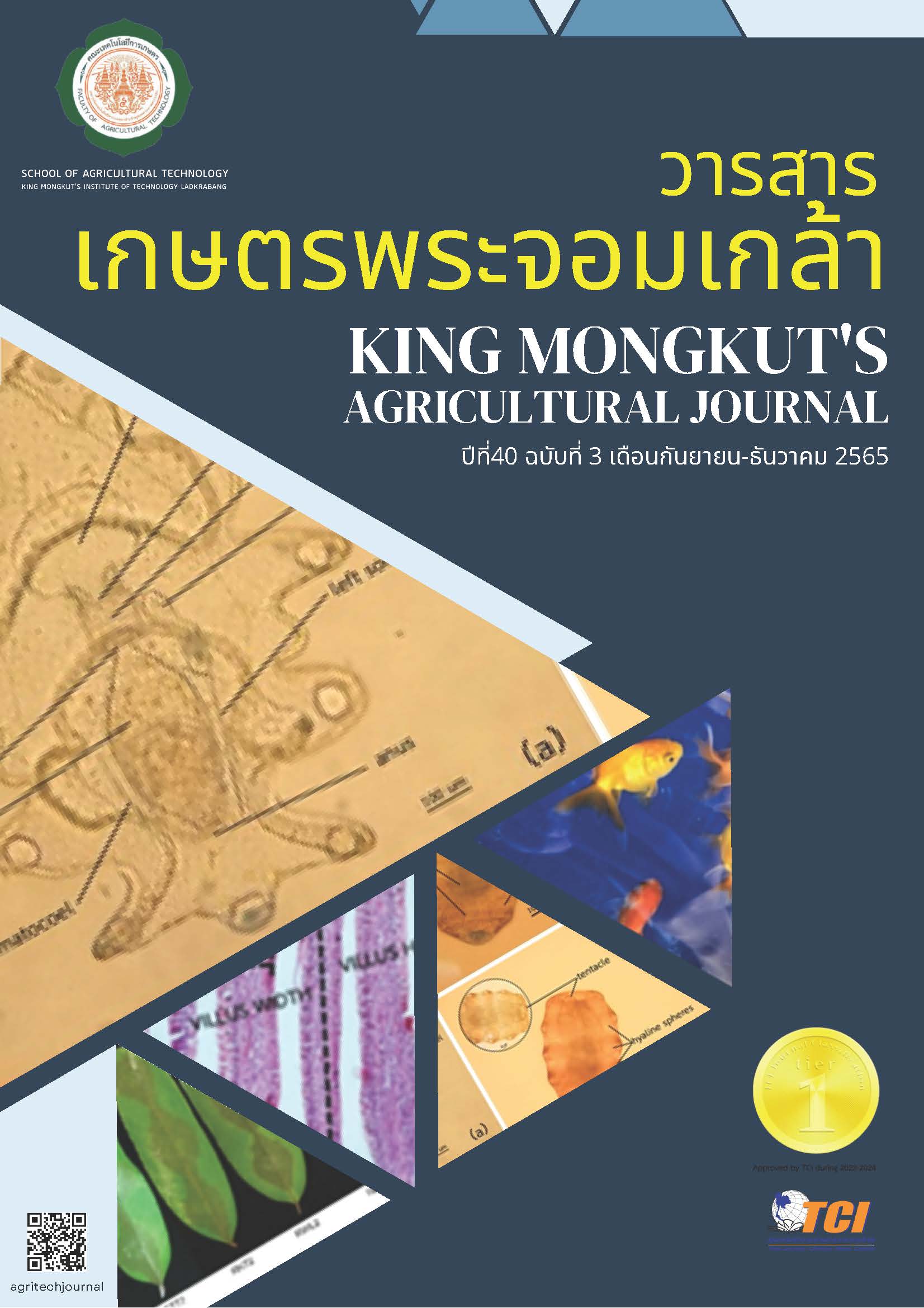ความต้านทานสารเคมีแมนโคเซบของเชื้อรา Phytophthora palmivora สาเหตุโรค ลำต้นเน่าและใบไหม้ของทุเรียนในแหล่งปลูกภาคตะวันออกของประเทศไทย
Main Article Content
บทคัดย่อ
ภาคตะวันออกเป็นแหล่งปลูกทุเรียนที่สำคัญของประเทศไทย ในแหล่งปลูกมักพบการแพร่ระบาดของโรครากเน่า ลำต้นเน่า และใบไหม้ที่มีสาเหตุจากเชื้อรา Phytophthora palmivora อยู่เสมอ จึงทำให้เกิดการสูญเสียผลผลิตเป็นจำนวนมาก เป็นเหตุให้เกษตรกรมีการใช้สารเคมีป้องกันกำจัดเชื้อราชนิดเดิมต่อเนื่องเป็นเวลานาน ซึ่งอาจทำให้เชื้อราพัฒนาเกิดความต้านทานขึ้น งานวิจัยนี้มีวัตถุประสงค์เพื่อทดสอบความสามารถในการก่อโรคของเชื้อรา จำแนกชนิดของเชื้อราด้วยวิธีชีวโมเลกุล และศึกษาความต้านทานของเชื้อราต่อสารเคมีแมนโคเซบ โดยแยกเชื้อจากทุเรียนที่เป็นโรคจาก 3 จังหวัด ได้แก่ จันทบุรี ระยอง และตราด พบว่าได้เชื้อรา Phytophthora spp. 40 ไอโซเลท โดยทุกไอโซเลทสามารถก่อโรคที่มีลักษณะใบไหม้คล้ายอาการช้ำน้ำ มีขนาดแผลตั้งแต่ 1 เซนติเมตรขึ้นไป เชื้อราทุกไอโซเลทได้รับการยืนยันในระดับสปีชี่ส์โดยศึกษาลำดับนิวคลีโอไทด์บริเวณ ITS ว่าเป็น P. palmivora จากการทดสอบความต้านทานของเชื้อราต่อสารเคมีบนอาหารเลี้ยงเชื้อ พบว่ามี 3 ไอโซเลทจาก 40 ไอโซเลทเกิดความต้านทานต่อสารเคมีแมนโคเซบ มีค่า EC50 103.4 – 109.86 ppm ซึ่งเป็นเชื้อที่ได้จากจังหวัดจันทบุรีและระยอง ในทำนองเดียวกันเมื่อทดสอบความต้านทานบนเนื้อเยื่อใบทุเรียน พบว่าตัวแทนไอโซเลทที่อ่อนแอต่อสารเคมีบนอาหารเลี้ยงเชื้อ มีค่า EC50 13.29 – 15.64 ppm ส่วนตัวแทนไอโซเลทที่ต้านทานต่อสารเคมีบนอาหารเลี้ยงเชื้อ มีค่า EC50 >1000 ppm ซึ่งถูกจัดอยู่ในกลุ่มอ่อนแอและต้านทานต่อแมนโคเซบ ตามลำดับ เช่นเดียวกับบนอาหารเลี้ยงเชื้อ ดังนั้นข้อมูลที่ได้จากงานวิจัยนี้จะเป็นประโยชน์ในการเลือกใช้สารเคมีกลุ่มอื่นเพื่อทดแทนสารเคมีในกลุ่ม Dithiocarbamate ในการควบคุมโรคของทุเรียนที่มีสาเหตุจากเชื้อรา P. palmivora ในแหล่งปลูกภาคตะวันออกของประเทศไทยต่อไป
Article Details

อนุญาตภายใต้เงื่อนไข Creative Commons Attribution-NonCommercial-NoDerivatives 4.0 International License.
วารสารเกษตรพระจอมเกล้า
เอกสารอ้างอิง
Koohapitagtam, M. (2018). Kānsưksā Laksana Thāng Santhānvitthaya læ Kānkœ̄trōk khō̜ng Chư̄arā Phytophthora palmivora Sāhēt Rōkrāknao læ Khōnnao khō̜ng Thurīan Nai Prathedthai [Characterization of morphology and pathogenicity of Phytophthora palmivora a causal agent of root rot and stem rot of durian in Thailand]. Research. Burapha University.
Prommate, A., Valyasevi, S., Arunothayanan, H., McGovern, R. J., Cheewankoon, R., & To-anun, C. (2019). Prasitthiphāp khō̜ng Rā Patipak Chaetomium spp. Tō̜ *Phytophthora palmivora (P-hā) Sāhēt Rōkrāklækhōnnao Thurīan. Khon Kaen Agriculture Journal. 47(6), 1251-1264
Araújo, E. R., Resende, R. S., Alves, D. P., & Higashikawa, F. S. (2020). Field efficacy of fungicides to control downy mildew of onion. European Journal of Plant Pathology. 156(1), 305-309
Chacón, M. G., Caicedo, E., & Ordóñez, M. E. (2022). Sensitivity to metalaxyl, mefenoxam, and cymoxanil in Phytophthora andina isolates collected from tree tomato (Solanum betaceum) in Ecuador. Tropical Plant Pathology. doi:10.1007/s40858-022-00512-1
Chi, N. M., Thu, P. Q., Nam, H. B., Quang, D. Q., Phong, L. V., Van, N. D., Trang, T. T., Kien, T. T., Tam, T. T. T., & Dell, B. (2020). Management of Phytophthora palmivora disease in Citrus reticulata with chemical fungicides. Journal of General Plant Pathology. 86(6), 494-502
Doyle, J. J., & Doyle, J. L. (1987). A rapid DNA isolation procedure for small quantities of fresh leaf tissue. Phytochemical Bulletin. 19(1): 11-15.
FRAC. (2022). FRAC Code List ©*2022: Fungal control agents sorted by cross-resistance pattern and mode of action (including coding for FRAC Groups on product labels). Retrieved from: https://www.frac.info/fungicide-resistance-management
Gullino, M. L., Tinivella, F., Garibaldi, A., Kemmitt, G. M., Bacci, L., & Sheppard, B. (2010). Mancozeb: past, present, and future. Plant Disease. 94: 1076–87.
Ivanov, A. A., Ukladov, E. O., & Golubeva, T. S. (2021). Phytophthora infestans: An overview of methods and attempts to combat late blight. Journal of Fungi. 7(12), 1071
Jeffers, S. N., & Martin, S. B. (1986). Comparison of two media selective for Phytophthora and Pythium species. Plant Disease. 70(11), 1038-1043
Sijpesteijn, A. K. (1984). Mode of action of some traditional fungicides. In: Trinci, A. P. J., & Ryley, J. F., Mode of Action of Antifungal Agents: Symposium series-British Mycological Society (pp. 135-153). Cambridge: Cambridge University Press.
Kongtragoul, P., Ishikawa, K., & Ishii, H. (2021). Metalaxyl resistance of Phytophthora palmivora causing durian diseases in Thailand. Horticulturae. 7(10), 375
Lu, X. H., Zhu, S. S., Bi, Y., Liu, X. L., & Hao, J. J. (2010). Baseline sensitivity and resistance-risk assessment of Phytophthora capsici to iprovalicarb. Phytopathology. 100(11), 1162-1168.
Malandrakis, A. A., Apostolidou, Z. A., Markoglou, A., & Flouri, F. (2015). Fitness and cross-resistance of Alternaria alternata field isolates with specific or multiple resistance to single site inhibitors and mancozeb. European Journal of Plant Pathology. 142(3), 489-499
Moreira, R. R., Hamada, N. A., Peres, N. A., & De Mio, L. L. M. (2019). Sensitivity of the Colletotrichum acutatum Species Complex from Apple Trees in Brazil to Dithiocarbamates, Methyl Benzimidazole Carbamates, and Quinone Outside Inhibitor Fungicides. Plant Disease. 103(10), 2569-2576
Puig, A. S., Quintanilla, W., Matsumoto, T., Keith, L., Gutierrez, O. A., & Marelli, J. P. (2021). Phytophthora palmivora Causing Disease on Theobroma cacao in Hawaii. Agriculture. 11(5), 396
Ramírez‐Gil, J. G., Castañeda‐Sánchez, D. A., & Morales‐Osorio, J. G. (2017). Production of avocado trees infected with Phytophthora cinnamomi under different management regimes. Plant Pathology. 66(4), 623-632
Rekanović, E., Potočnik, I., Milijašević-Marčić, S., Stepanović, M., Todorović, B., & Mihajlović, M. (2012). Toxicity of metalaxyl, azoxystrobin, dimethomorph, cymoxanil, zoxamide and mancozeb to Phytophthora infestans isolates from Serbia. Journal of Environmental Science and Health. 47(5), 403-409
Suzui, T., Kueprakone, U., & Kamphangridthrong, T. (1979). Phytophthora spp. isolated from some economic plants in Thailand. Technical Bulletins. 12, 32-41
Wong, F. P., & Wilcox, W. F. (2001). Comparative physical modes of action of azoxystrobin, mancozeb, and metalaxyl against Plasmopara viticola (grapevine downy mildew). Plant Disease. 85(6), 649-656
Wu, Y., Lu, S., Huang, S., Fu, G., Chen, L., Xie, D., Li, Q., & Cen, Z. (2011). Field resistance of Phytophthora melonis to metalaxyl in South China. Wei Sheng Wu Xue Bao. 51(8), 1078-1086.
Yang, L. N., He, M. H., Ouyang, H. B., Zhu, W., Pan, Z. C., Sui, Q. J., Shang, L. P., & Zhan, J. (2019). Cross-resistance of the pathogenic fungus Alternaria alternata to fungicides with different modes of action. BMC Microbiology. 19(1), 1-10
Zhao, X., Ren, L., Yin, H., Zhou, J., Han, J., & Luo, Y. (2013). Sensitivity of Pseudoperonospora cubensis to dimethomorph, metalaxyl and fosetyl-aluminium in Shanxi of China. Crop Protection. 43, 38-44


